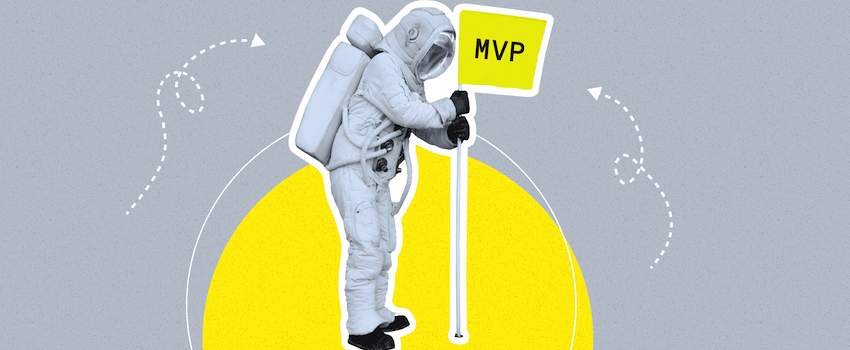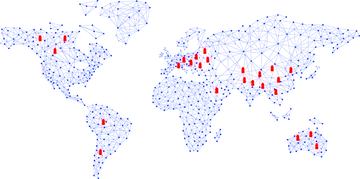Last year, a bootstrapped startup founder from North America came to us with nothing but a Figma prototype and a fierce deadline. He had a peculiar demand, “I need you to build a SaaS MVP in 8 weeks. No excuses. It has to launch.” Spoiler: we launched in 7.5 weeks!
Now, this wasn’t some lucky break. This is a proven framework and it’s repeatable. At CredibleSoft, I’ve overseen dozens of rapid SaaS MVP development projects, especially for startups looking to develop SaaS apps, validate fast and scale with agility. If you’re looking for expert help with agile SaaS MVP development, MVP launch planning, and startup product strategy, you’re in the right place. In this article, I’ll show you exactly how to build, launch, and scale your SaaS MVP quickly, without cutting corners on quality and how partnering with an experienced MVP development service company can help you launch faster and avoid costly mistakes.
How to Fast-Track SaaS MVP Development: 8-Week Launch Strategy for Startups
Many founders underestimate MVP development challenges, from defining core features to keeping scope creep in check. If you’re a startup founder, product lead, or CTO trying to launch your SaaS MVP off the ground fast, you’re in the right place. We’ll break down a proven 8-week launch strategy, covering everything from scoping to deployment, with clear action steps, real-world examples, tool stacks, decision frameworks, and best practices for how to build a MVP.

Why Fast-Tracking is Important when Building a SaaS MVP
Speed isn’t just a vanity metric. The faster you validate, the faster you iterate, pivot, or scale. As a matter of fact, time kills startups more than bad code ever will.
Every week you delay is a week you’re not getting user feedback, not testing pricing, not learning what actually matters. SaaS MVP development done right is your startup’s fastest path to traction or failure, which is equally valuable if it saves you 12 months of wasted effort.
In this hyper-competitive software industry, time-to-market is your biggest advantage. Agile SaaS development allows you to minimize risk, lower initial investment, and maximize learning.
Understanding the SaaS MVP Mindset
Before jumping into timelines and tech stacks, it’s important to adopt the right mindset. A minimum viable product (MVP) is not a beta version of your final product. It’s a functional tool that solves a specific problem for a specific user segment. In fact, the best SaaS MVPs are ones that launch quickly and focus entirely on user feedback loops.
FIND OUT: How to Integrate DevOps Quality Gates into CI/CD Pipeline to Improve QA & Deployments
You should be asking: “What’s the smallest version of my product that still delivers value?” and not “How do I build a miniature version of the full product?” That subtle mindset shift can shave weeks off your timeline.
The 8-Week SaaS MVP Blueprint: How to Build, Launch, and Grow Faster
Launching a SaaS MVP doesn’t have to take forever or drain your resources. With the right approach, you can go from idea to a working minimum viable product (MVP) in just eight weeks. This SaaS MVP blueprint is built for founders, developers, and lean startup teams who want to launch fast without sacrificing quality. Whether you’re building a SaaS MVP from scratch or validating a SaaS startup idea, this guide walks you through every step: choosing the right tech stack, defining core features, and applying lean MVP launch tactics that get real results.
You’ll learn how to identify user pain points, prioritize what to build, and create momentum early using practical SaaS product marketing strategies. This framework helps you avoid common pitfalls, cut down on wasted time, and focus on what actually drives traction. If you’re serious about bringing your product to market quickly and growing with purpose, this is your step-by-step plan to build smarter and grow faster.
If you’re short on time or technical resources, understanding why your startup needs an MVP development service company can be the key to launching a polished product faster and with less risk.
Week 1: Define a Ruthlessly Focused MVP Scope
When building a SaaS MVP, the first trap most founders fall into is scope creep disguised as “must-have” features. Everyone wants a feature-rich app, but that mindset kills velocity.
Here’s how we counter that:
-
- Start with your core user journey. What’s the one outcome your user cares about most?
- Use the MoSCoW method (Must-have, Should-have, Could-have, Won’t-have). Be brutal. Only build the “Musts.”
- Use tools like Miro or Whimsical to map out the user flow before writing a single line of code.
Example: For a recent SaaS client offering freelance invoice automation, we cut scope by 60 percent. Instead of a full billing dashboard, we focused on auto-generating PDF invoices from a form. That got them users fast, and they started getting feedback within days.
You also need to make sure your scope aligns with your business goals. If your MVP can’t validate your value proposition or test your pricing model, you’re wasting effort.
Checklist for Week 1 (when Building a SaaS MVP):
-
- Define one primary user persona
- Map the end-to-end journey for their core goal
- Prioritize features using MoSCoW
- Finalize tech stack and development team roles
Pro Tip: Use a lean canvas to align product goals with business goals. This ensures your MVP stays focused on solving one meaningful problem.
Week 2 to 3: Design and Prototype with Just Enough Polish
I’ve seen MVPs die in Figma purgatory. Don’t over-polish your design. Keep it clean, modern, and aligned with current UI/UX design trends, but remember that you’re not building for Dribbble. You’re building a SaaS MVP to learn and validate.
What works:
-
- Low-fidelity wireframes followed by feedback loops, then high-fidelity mockups
- Tools like Figma and FigJam for collaborative iteration
- Fast usability tests with 5 to 7 real users
Case reference: For a B2B inventory tracking MVP, we used pre-built Tailwind UI components in Figma. Design took four days. Testing with six warehouse managers revealed we had misjudged their workflow, saving us three weeks of wasted development.
It’s also smart to integrate your design process with development planning. Therefore, we always include engineers in early design reviews. This ensures feasibility, avoids redesign, and accelerates handoff.
Checklist for Week 2 to 3 (when Building a SaaS MVP):
-
- Complete wireframes for core screens
- Run multiple rounds of user feedback
- Finalize design components and style guide
- Create clickable prototype for stakeholder validation
Week 4 to 6: Build the SaaS MVP Using a Battle-Tested Tech Stack
Tech stack can make or break your 8-week timeline. Don’t experiment. Use tools your team knows or tech with velocity and strong community support.
FIND OUT: Top 10+ Cross-Browser Testing Strategies for Hybrid Mobile Applications
Recommended Tech Stack for Speed and Scale:
-
- Frontend: React or Next.js with Tailwind CSS for rapid UI development
- Backend: Node.js or Django, depending on team familiarity
- Database: PostgreSQL (stable and scalable)
- Authentication: Firebase Auth or Supabase
- Hosting: Vercel, Render, or Heroku for painless deployments
- CI/CD: GitHub Actions with Docker (keep deployment streamlined)
Real-world note: At CredibleSoft, we use this exact stack for 80 percent of SaaS MVPs. Unless your domain requires something custom, go with proven, reliable, and fast frameworks.
MVP Development Best Practices:
-
- Use component libraries like Radix or shadcn/ui
- Push code to a staging environment daily
- Document APIs using Swagger or Postman
- Write unit and integration tests for core features
- Keep feature branches lean and code reviews sharp
Checklist for Week 4 to 6 (when Building a SaaS MVP):
-
- Backend scaffolding complete (models, routes, auth)
- Build frontend incrementally in feature slices
- Connect database and integrate APIs
- Set up CI/CD and staging environment
- Write and run tests continuously
Week 7: QA, UAT, and Real Feedback Loops
Here’s where most startups drop the ball. Don’t treat QA like an afterthought or a single phase. Instead, treat it as a continuous process. Therefore, we run automated tests and manual exploratory testing from Day 1. But in Week 7, the focus shifts to real users and real scenarios. Comprehensive MVP testing helps ensure your product solves the right problem before you invest heavily in full-scale development.
Testing Strategies That Work when Building a SaaS MVP:
-
- Use Playwright or Cypress for automated end-to-end tests
- Prepare a UAT checklist based on your original MVP scope
- Conduct manual tests with non-technical team members
- Use session replay tools like LogRocket to detect real-world bugs
Example: A fintech MVP we built passed 100 percent of QA, but crashed when a beta tester uploaded a 15MB CSV file. Lesson learned: edge cases only show up in real-world usage.
Checklist for Week 7 (when Building a SaaS MVP):
-
- Complete regression testing across all devices
- Run structured user acceptance testing
- Log and fix all critical bugs and UX blockers
- Prepare marketing assets and support docs
Week 8: Launch, Measure, and Iterate
Now it’s time to launch, but do it smartly. A successful MVP launch isn’t about going live. Actually, it’s about learning, iterating, and scaling.
Post-launch Essentials:
- Integrate product analytics tools like Mixpanel or PostHog
- Set up heatmaps with Hotjar or Smartlook
- Track key SaaS KPIs: signups, activation rate, churn, and retention
- Interview your first 10 to 20 users to find friction points
Bonus Tip: Enable live chat with Intercom or Crisp during your first 2 weeks. It’s the fastest way to collect qualitative feedback from confused or stuck users.
Portfolio insight: For a logistics SaaS MVP, we fixed a broken onboarding flow within 48 hours of launch after spotting friction in Hotjar session recordings. Activation rates tripled the following week.
Checklist for Week 8 (when Building a SaaS MVP):
-
- Launch MVP to early adopters or public beta
- Monitor analytics and performance metrics daily
- Schedule user interviews and support calls
- Prioritize next sprint based on real usage data
Week 9 and Beyond: Iteration, Feedback, and Scaling
While this is technically beyond your 8-week SaaS MVP launch, it’s crucial to plan your post-MVP roadmap.
FIND OUT: Why SEO Fails Without QA: The Secret to Scalable Digital Marketing
Here’s what we recommend:
-
- Implement a structured feedback loop with tools like Notion or Productboard
- Prioritize bug fixes, onboarding friction, and most requested features
- Keep your MVP lightweight, but prepare your codebase for scalability
- Begin work on a growth funnel: email onboarding, pricing tests, referral systems
If users are asking for integrations, consider tools like Zapier, webhooks, or public APIs to increase product stickiness and retention without heavy development.
Final Thoughts: How to Build a SaaS MVP in 8-Weeks
Launching a SaaS MVP in 8 weeks is absolutely possible. We’ve done it repeatedly across industries. But it demands focus, commitment, and clarity.
However, remember to stop polishing and stop waiting for perfection. Just launch, learn and iterate.
At CredibleSoft, we partner with startups around the world to bring SaaS MVPs to life in record time. We offer full-cycle MVP development, UI/UX design, QA automation, cloud infrastructure setup, and agile product delivery. Whether you need an offshore development partner or a dedicated product team, we bring experience, efficiency, and relentless focus. Let’s schedule a free MVP strategy session with us today.
About the Author: Debasis Pradhan is the Founder and CEO of CredibleSoft, a global leader in software QA and development. With over 20 years of hands-on experience in test automation, software quality engineering, and digital transformation, he is known for his unwavering commitment to delivering enterprise-grade software solutions with precision and reliability. 🔔 Follow Deb on LinkedIn





